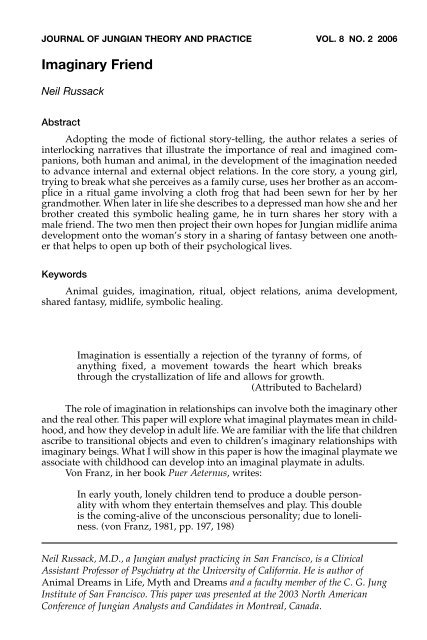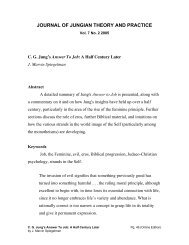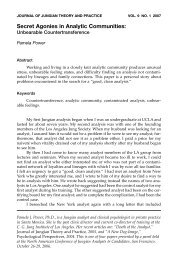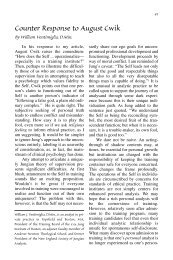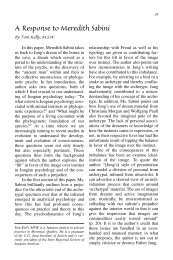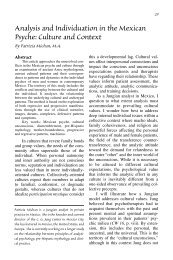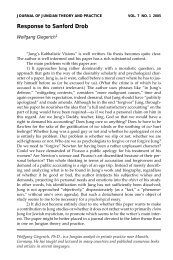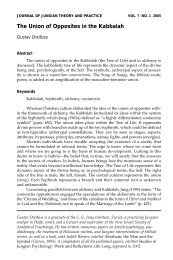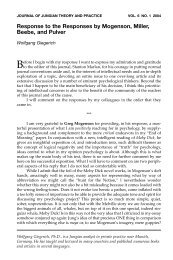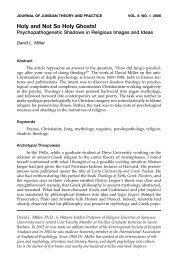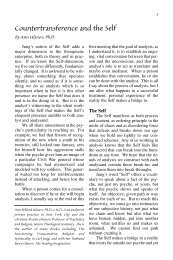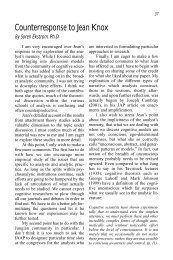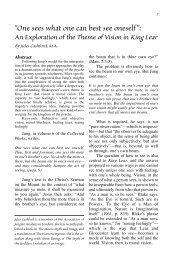Imaginary Friend - CG Jung Institute of New York
Imaginary Friend - CG Jung Institute of New York
Imaginary Friend - CG Jung Institute of New York
Create successful ePaper yourself
Turn your PDF publications into a flip-book with our unique Google optimized e-Paper software.
JOURNAL OF JUNGIAN THEORY AND PRACTICE VOL. 8 NO. 2 2006<br />
<strong>Imaginary</strong> <strong>Friend</strong><br />
Neil Russack<br />
Abstract<br />
Adopting the mode <strong>of</strong> fictional story-telling, the author relates a series <strong>of</strong><br />
interlocking narratives that illustrate the importance <strong>of</strong> real and imagined companions,<br />
both human and animal, in the development <strong>of</strong> the imagination needed<br />
to advance internal and external object relations. In the core story, a young girl,<br />
trying to break what she perceives as a family curse, uses her brother as an accomplice<br />
in a ritual game involving a cloth frog that had been sewn for her by her<br />
grandmother. When later in life she describes to a depressed man how she and her<br />
brother created this symbolic healing game, he in turn shares her story with a<br />
male friend. The two men then project their own hopes for <strong>Jung</strong>ian midlife anima<br />
development onto the woman’s story in a sharing <strong>of</strong> fantasy between one another<br />
that helps to open up both <strong>of</strong> their psychological lives.<br />
Keywords<br />
Animal guides, imagination, ritual, object relations, anima development,<br />
shared fantasy, midlife, symbolic healing.<br />
Imagination is essentially a rejection <strong>of</strong> the tyranny <strong>of</strong> forms, <strong>of</strong><br />
anything fixed, a movement towards the heart which breaks<br />
through the crystallization <strong>of</strong> life and allows for growth.<br />
(Attributed to Bachelard)<br />
The role <strong>of</strong> imagination in relationships can involve both the imaginary other<br />
and the real other. This paper will explore what imaginal playmates mean in childhood,<br />
and how they develop in adult life. We are familiar with the life that children<br />
ascribe to transitional objects and even to children’s imaginary relationships with<br />
imaginary beings. What I will show in this paper is how the imaginal playmate we<br />
associate with childhood can develop into an imaginal playmate in adults.<br />
Von Franz, in her book Puer Aeternus, writes:<br />
In early youth, lonely children tend to produce a double personality<br />
with whom they entertain themselves and play. This double<br />
is the coming-alive <strong>of</strong> the unconscious personality; due to loneliness.<br />
(von Franz, 1981, pp. 197, 198)<br />
Neil Russack, M.D., a <strong>Jung</strong>ian analyst practicing in San Francisco, is a Clinical<br />
Assistant Pr<strong>of</strong>essor <strong>of</strong> Psychiatry at the University <strong>of</strong> California. He is author <strong>of</strong><br />
Animal Dreams in Life, Myth and Dreams and a faculty member <strong>of</strong> the C. G. <strong>Jung</strong><br />
<strong>Institute</strong> <strong>of</strong> San Francisco. This paper was presented at the 2003 North American<br />
Conference <strong>of</strong> <strong>Jung</strong>ian Analysts and Candidates in Montreal, Canada.
2 <strong>Imaginary</strong> <strong>Friend</strong><br />
She goes on to discuss the archetypal expression <strong>of</strong> this other as it has manifested<br />
in primitive societies, in which the human, when born, is split into two,<br />
one half entering this world and the other remaining in the spirit world: upon<br />
death, they reunite. Psychologically, this mirrors the split between the conscious<br />
and unconscious aspects <strong>of</strong> the personality (p. 199).<br />
In the events used as illustration in this paper, a man developed an imaginal,<br />
but real, relationship with a woman. Because they did not become lovers, they<br />
were able to enter into an imaginal realm, just as children might when they play<br />
imaginary games together. For the man, the relationship came to embody an<br />
aspect <strong>of</strong> his undeveloped imagination, healing him <strong>of</strong> an early wound <strong>of</strong> isolation<br />
and loneliness.<br />
Because there is a high emotional tension in projected relationships, it is difficult<br />
to hold a balance between allowing an exploration to occur, with the risk <strong>of</strong><br />
literal enactment, and cutting it <strong>of</strong>f altogether, thus losing its potential healing<br />
value. What I will show is how an adult can enter a pr<strong>of</strong>ound union, a union that<br />
gives him an ecstatic connection to his own inner world. Between enactment and<br />
repression, there is a middle way. How we meet the other in this way, in or out <strong>of</strong><br />
analysis, can be crucial.<br />
I discovered this, vicariously, through my connection to a man named Nigel.<br />
He was my neighbor, and he and I took walks together after our dogs introduced<br />
us. Nigel’s dog, Maggie, was a pretty but finicky Blue Heeler, an Australian cattle<br />
dog, and my dog, Moss, was an older, patient Border Collie, a sheep dog. The two<br />
dogs became familiars who opened a twilight world in which the two <strong>of</strong> us could<br />
talk openly and intimately.<br />
Nigel was a pr<strong>of</strong>essor, originally English, and had been close to a sister who<br />
was his psychic companion in childhood and who died just before he came to the<br />
U.S. to college. Even though he spoke lovingly <strong>of</strong> his wife and their eight-year-old<br />
daughter, he seemed lonely.<br />
After Moss died we kept up our custom <strong>of</strong> walking and, as if the opening<br />
made in me by grief called forth an opening in him, he told me how he had<br />
become captivated by a beautiful, younger Polish woman, Sophie. When they<br />
met, she felt a sympathy with him and began immediately to tell him the story <strong>of</strong><br />
her close childhood relationship to her brother. From that first moment <strong>of</strong> storytelling,<br />
he stood spellbound, like the wedding guest in Coleridge’s The Rime <strong>of</strong> the<br />
Ancient Mariner.<br />
Sophie’s story began with her grandmother Ada. An uneducated woman,<br />
she was the daughter <strong>of</strong> a glove maker, a tyrant who gave no money to his wife.<br />
From age twelve, Ada would stay late in the factory making gloves so as to have<br />
money to give her mother. She married young and was happy with her husband,<br />
but life was hard through two world wars. She loved her grandchildren and got<br />
the idea to please them by transforming gloves into frogs. Being about the same<br />
size, the captive fingers <strong>of</strong> the glove filled with rice became the frog’s wiggly<br />
limbs. The grandmother sewed the frogs at night and placed them on the sleeping<br />
children’s pillows. The old woman, brought up in a strict, dutiful household,<br />
wove all her repressed feeling into these animals, and as a result they seemed<br />
magical. The grandchildren, delighted to discover these frogs in the morning,<br />
incorporated them into remarkable imaginative play; they ritually killed and res-
Neil Russack 3<br />
urrected them. They remind me <strong>of</strong> the magic toys that come to life at night in<br />
E.T.A. H<strong>of</strong>fman’s Nutcracker Story or Hans Christian Anderson’s The Steadfast Tin<br />
Soldier.<br />
I could see how Nigel was captivated by Sophie’s story and, to my surprise,<br />
I found myself captivated too and making notes drawing on my own long habit<br />
<strong>of</strong> keeping clinical records. Nigel himself, trained as a scholar, kept a journal <strong>of</strong> the<br />
things she said. Much later, after the connection had more or less run its course,<br />
he shared his notes with me. By then my imagination had entered so fully into this<br />
vicarious relationship that, when I read Nigel’s notes, it was as though I could<br />
hear Sophie speaking directly.<br />
Sophie was six or seven when she and her brother began playing with legos.<br />
They made structures like airplanes and got the idea that these cloth frogs could<br />
drive the planes. “She, the frog, has to drive these things,” Sophie explained.<br />
“Being mischievous, behind my grandmother’s back we used to throw these<br />
newly made lego structures against the walls. We would build them to throw<br />
them. We could be quite destructive, as children sometimes are. I don’t know how<br />
we decided to kill our frogs; I think it just happened. We built funerary vessels for<br />
the frogs out <strong>of</strong> legos <strong>of</strong> specially chosen primary colors, blues and greens. Each<br />
<strong>of</strong> us had our own unique vessel.”<br />
Sophie’s grandmother transmuted gloves to frogs, the children transmuted<br />
frogs into something else. It was like an assembly line for the imagination. From<br />
these homespun animals, a frog ritual evolves. Her brother is in tune with the<br />
magical world and she, inspired by him, follows his lead. “Without him,” Sophie<br />
tells Nigel, “I don’t know that I would have developed.”<br />
She went on: “My brother would make my frog’s funerary vessel and I his. We<br />
felt that the frog was meant to have this happen. It was her fate. To the accompaniment<br />
<strong>of</strong> the rock group ‘The Doors,’ we would stand at the top <strong>of</strong> the cellar stairs<br />
and one at a time hurl these funerary assemblages down the cellar steps to crash<br />
below. Seeing the flight <strong>of</strong> the c<strong>of</strong>fin over the staircase, knowing they were going to<br />
their deaths, was terribly exciting. We would gather up our killed frogs and then,<br />
and only then, did they truly belong to us. They had to die before they could be<br />
ours. By killing them, we freed them up to become themselves. My brother and I<br />
worshipped our frogs and carried them around with us wherever we went.”<br />
Sophie recounted that “each frog went through one major funeral. It was an<br />
initiatory experience. Then she got to drive anything after that. She was a royal<br />
frog. My brother’s frog was white and red and I was very jealous <strong>of</strong> his frog. It was<br />
very organic, very voluptuous, very fat. My frog was more tailored, more civilized.<br />
It had more shape to it. It was red and black, the color <strong>of</strong> the underworld,<br />
and reminds me now <strong>of</strong> that Greek story <strong>of</strong> Persephone eating the pomegranate.<br />
My brother’s frog was more original, more primitive. What his frog looked like<br />
was not important to him. The frog didn’t need to be an expression <strong>of</strong> him. He was<br />
not as identified with it as I was.”<br />
She continued: “The killing <strong>of</strong> the frogs freed their spirit, which meant that<br />
we, too, were freed from the family curse which was a lack <strong>of</strong> warmth. We needed<br />
to use our imagination and express our feelings. We had a deep commitment<br />
to one another and we would talk to one another through our animals. My animal<br />
would talk to his animal. This led, later on, to my doing puppetry for children.”
4 <strong>Imaginary</strong> <strong>Friend</strong><br />
Sophie explained that the funerary games were played in secret. She said:<br />
“We were afraid our grandmother would find out. When she did catch us; she<br />
would exclaim, ‘What are you doing? You are destroying frogs and furniture,’ and<br />
we would laugh and then she would laugh. Then we would pick them up with<br />
great excitement, put them with their back on our palm face up as if they were<br />
dead. We would carry them out <strong>of</strong> there, as if they had seen something on their<br />
journey down the stairs.<br />
“My brother and I were very tight. We would throw our frogs at the same<br />
time. We would look into each other’s eyes, like lovers, like we were going to die.<br />
It was like stepping into a third place between two people; it was a chemical reaction.<br />
It is always easier to die with someone else, to discover something known on<br />
the other side, that eternal thing. We looked for it in childhood. It was a most liberating<br />
event for children. It bonded my brother and I, knowing the trust <strong>of</strong> the<br />
dark elements <strong>of</strong> God.<br />
“Finding out about the ritual didn’t stop my grandmother from making animals<br />
for us. She made them for us throughout her life; the last one six months<br />
before she died. She always knew what they meant for us. She would stop everything<br />
when we would run to her crying, ‘She’s wounded, she’s bleeding,’ when<br />
the skin <strong>of</strong> the frog would break and rice would spill out, falling over us. There<br />
was a sense <strong>of</strong> urgency. We would become particularly excited when this happened.<br />
The frog might be dying. We knew on one level it was a game, but it<br />
seemed terribly real. We knew grandmother could repair it, we were helped by<br />
knowing she could heal. She would soothe us with her warm smile, yet she<br />
enjoyed the power as the only one we could turn to. She could give life back to the<br />
frogs. My mother on the other hand wouldn’t respond. When Teddy, (my teddy<br />
bear), lost an ear and I would run to my mother crying, ‘Teddy can’t hear,’ my<br />
mother wouldn’t care. She wouldn’t fix it and I was devastated.<br />
“What we were really saying when we brought injured frogs to grandmother<br />
was ‘Can you fix us, can you heal us?’ Even now I see these frogs still there, still<br />
standing, not losing sustenance. It makes me feel like everything is o.k.<br />
“Each time the frog underwent a death and rebirth, it became more special.<br />
It had survived. A frog hierarchy developed; the older ones had been through hell<br />
and back whereas the newer frogs were not as important because they didn’t<br />
know anything.<br />
“When Grandma said she had new thread that wouldn’t show, we didn’t<br />
want that. Each frog had a cosmic scar. If we kept her from that, she wouldn’t<br />
come into her own. The frogs had to remain vulnerable, they had to be responsible<br />
for their actions. Every time we threw a frog down, we felt the fire. We were<br />
compelled to do this. It was the inevitable fate <strong>of</strong> the frog. We realized that she was<br />
on an immense journey. Now I think it had to do with coming to terms with the<br />
greater design <strong>of</strong> things.<br />
“There was a feeling <strong>of</strong> urgency. Children have a feeling for that. The frog<br />
needed to die. Everything built up to that moment. It was a pr<strong>of</strong>ound moment<br />
which I couldn’t have done alone. I needed a partner on the journey to the underworld.<br />
“I was a child who kept to herself and my brother opened me up. He would<br />
come into my room with fantastic ideas and new ways <strong>of</strong> seeing the world. He
Neil Russack 5<br />
would suggest games and show me his new inventions. He would bring in Pink<br />
Floyd records.”<br />
Sophie and her brother remained close their whole life, but she married and<br />
went on to develop a career. He, on the other hand, became more and more withdrawn,<br />
and eventually killed himself.<br />
Listening to Nigel retell Sophie’s story in the dark <strong>of</strong> the night, I could hear<br />
the trembling <strong>of</strong> Nigel’s voice and its reverberations in his limbs when he would<br />
stop or wave his arm. Often it was as though he were talking to himself or to some<br />
imaginary figure up ahead, rather than to me. I could feel a fever in Nigel’s thinking<br />
about Sophie, as if there were now two people inside him, he and she, spellbound<br />
by her enchanted frog. Evoking the c<strong>of</strong>fin in the story, he covets what he<br />
lost. In carefully writing down Sophie’s words, it was as if Nigel were recovering<br />
the imaginary play with his own sister; Sophie’s words became a secret code to fill<br />
the void. Hearing about the children’s violent and ecstatic emotions, as the frog<br />
transformed, affected me also and grew into an unexpected feeling <strong>of</strong> well-being.<br />
I thought <strong>of</strong> exotic things, <strong>of</strong> travels in India, when I witnessed the fervor with<br />
which relatives ran chanting under torchlight through the narrow streets <strong>of</strong><br />
Varanasi, carrying the bodies <strong>of</strong> their loved ones to the burning ghats.<br />
Walking many nights in the dark with Nigel, I was drawn into his and<br />
Sophie’s story, not just by the intense eros that bound them to each other, but by<br />
the power <strong>of</strong> the imagination itself. I began to see that Sophie represented something<br />
to me too. Observing the intensity <strong>of</strong> his desire for Sophie, and the sorrow<br />
that was its natural accompaniment, I began to understand a great many things<br />
about my own early life. I noticed the heaviness and seriousness that hung in the<br />
air about me. I saw that I too had learned how to do things not out <strong>of</strong> joy but duty.<br />
In adult life, my spirit had been kindled by connections with animals, and<br />
these connections underlay my fascination with Sophie’s frog story. I knew from<br />
my studies that the frog is a symbol <strong>of</strong> rebirth. Its moist skin, retained from its loss<br />
<strong>of</strong> fish elements, was a way <strong>of</strong> staying close to the memory <strong>of</strong> the primary self and<br />
it lived around water its whole life. And I recalled the Frog Prince fairy-tale, <strong>of</strong> a<br />
little princess, who, by throwing a frog against the wall, transforms her instincts<br />
into human feeling. Why didn’t this knowledge satisfy me? Something still mysterious<br />
held me. I wanted to be with Sophie and her brother, throwing my frog<br />
down with theirs.<br />
Hearing the story <strong>of</strong> Sophie through Nigel, I began to wonder how I could<br />
retroactively enter the world <strong>of</strong> the imagination and receive the nourishment it<br />
<strong>of</strong>fered. C. G. <strong>Jung</strong> could play with stones in midlife to heal himself, and this<br />
worked because he had played with them as a child. I couldn’t just suddenly play<br />
with little frogs; there had to be another way <strong>of</strong> making up for the absence <strong>of</strong><br />
childhood connection to the world <strong>of</strong> imagination. So vicariously, through Nigel,<br />
I, too, connected with Sophie, who even at this remove became a guide for me, a<br />
way to find my way back, as an adult in an adult way.<br />
The reader may wonder how I could so easily enter into Nigel’s and Sophie’s<br />
world. The easy answer is that it’s my job to be affected by people, to let their<br />
worlds touch me so that I can accompany them. And there was something else here<br />
as well. You have to remember, it was night, and even though we walked with our
6 <strong>Imaginary</strong> <strong>Friend</strong><br />
dogs in our neighborhood, it felt as if we were on another planet. An intimacy<br />
developed between us, different from that between a doctor and his patient. I could<br />
feel myself entering his psyche and was reminded <strong>of</strong> Joseph Conrad’s story The<br />
Secret Sharer, in which a ship captain alone on watch in the dead <strong>of</strong> night in the<br />
South Seas picks up a half-dead man out <strong>of</strong> the water. The captain feels a strange<br />
empathy for the man. Conrad (1942) writes, “A mysterious communication was<br />
already established between us two—in the face <strong>of</strong> that silent, darkened tropical<br />
sea” (p. 273), and after hearing the swimmer’s story <strong>of</strong> murdering a shipmate on<br />
another ship and then escaping, the captain decides to hide him in his own cabin.<br />
As they begin to live secretly together in the small room, the captain realizes:<br />
He was not a bit like me, really; yet, as we stood leaning over my<br />
bed-place, whispering side by side, with our dark heads together<br />
and our backs to the door, anybody bold enough to open it<br />
stealthily would have been treated the uncanny sight <strong>of</strong> a double<br />
captain busy talking in whispers with his other self. (Conrad,<br />
1942, p. 276)<br />
The story ends when the secret sharer leaves the ship to swim for a nearby island,<br />
“a free man, a proud swimmer striking out for a new destiny” (p. 292).<br />
Walking with Nigel, I got an inkling <strong>of</strong> what it might feel like to strike out on<br />
my own, to live from my imagination, to have a life uniquely my own.<br />
The frog is on its journey too. She lets things happen to her. She surrenders<br />
to the ultimate change, death, and in the process, she is altered. Because she comes<br />
back from the dead she becomes a catalyst for transformation and thereby helps<br />
us to build a new internal structure. She becomes a psychic architect that opens us<br />
to the imaginal and teaches us to assimilate our imaginative experiences by making<br />
them our own. Sophie and her brother lost something <strong>of</strong> their individual<br />
selves by merging, and gained it back when both children wound up with their<br />
own frogs. Sophie told Nigel that the weight <strong>of</strong> the frog, which she would put on<br />
her chest at night to comfort her, made these changes real.<br />
The frog helped Sophie and Nigel and, eventually, vicariously, me, to objectify<br />
and stay rooted in the imaginary realm, as irrational as it was and as irrationally<br />
as it came about. It seemed strange to rely on an imaginary frog jumping<br />
about inside me. How could I fall under the enchantment <strong>of</strong> a woman’s frog?<br />
The British psychoanalyst Christopher Bollas, in his book The Shadow <strong>of</strong> the<br />
Object, Psychoanalysis <strong>of</strong> the Unthought Known, would conceive <strong>of</strong> Sophie’s frog as<br />
being a transformational object that refers to the child’s mother, the first transformational<br />
object. He finds that adults, in an attempt to reexperience this transformative<br />
process, search for an object with intense longing and a wish to fuse, “the<br />
object being identified with such powerful metamorphoses <strong>of</strong> being, . . .[with] the<br />
uncanny quality, the sense <strong>of</strong> being reminded <strong>of</strong> something never cognitively<br />
apprehended but existentially known” (Bollas, 1987, p. 17). Bollas speaks <strong>of</strong> Moby<br />
Dick, saying that “Ahab feels compelled to seek the whale, even though he feels<br />
alienated from the source <strong>of</strong> his own internal compulsion. . . . There is something<br />
impersonal and ruthless about the search for the whale, and indeed for all objects<br />
nominated as transformational; . . . The experience is neither social nor moral, . . .
Neil Russack 7<br />
as the object is sought out only as deliverer <strong>of</strong> an experience” (pp. 27, 29). This<br />
describes Nigel’s increasing desire for Sophie and my increasing fascination for<br />
their story.<br />
Edward Edinger (1995) refers to the white whale as a symbol <strong>of</strong> transformation<br />
that Ahab fails to understand. For a <strong>Jung</strong>ian, the unknowable thing that we<br />
are always in search <strong>of</strong> in our life is found in symbols and objects. What interests<br />
me in the comparison is that the search for the transformational object is just as<br />
powerful for both schools.<br />
As Nigel and Sophie began spending more time together, he grew alarmed<br />
and felt his life was out <strong>of</strong> control. She gave herself emotionally to him, in a way<br />
he thought not possible, not even as he remembered being with his sister. He<br />
began living in two worlds, one, the normal outer world <strong>of</strong> teaching and family,<br />
and this inner world <strong>of</strong> traveling with Sophie. He was at a turning point similar<br />
to one in the Conrad story, when the captain begins to talk to his first mate in<br />
whispers as if he is talking to his secret sharer and realizes that he can no longer<br />
keep his double secret.<br />
In listening to Nigel’s tale, I could see that part <strong>of</strong> Sophie was identified with<br />
Aphrodite, constellating the erotic wherever she went. He told me: “Sophie suggested<br />
a walk to a nearby beach. She was wearing an azure blue kerchief to match<br />
her aquamarine eyes, and an orange top. She looked like a young girl going on a<br />
picnic with her boyfriend. Excited to be near the water, she drew a magic circle<br />
around us in the sand. Then she told a dream in which blocks <strong>of</strong> color descended<br />
on her as a way <strong>of</strong> enticing her to come down to earth and remembered a magic<br />
circle her brother had placed them in to comfort her when she was frightened as<br />
a child.”<br />
At dusk, on the way back, Nigel said, the howls <strong>of</strong> coyotes encircled them,<br />
echoing <strong>of</strong>f the surrounding hills, giving them a sense that they were still in an<br />
imaginary space. “What are coyotes symbols <strong>of</strong>?” Nigel asked me. At midlife, I<br />
told him, he was entering that liminal zone, characterized by that trickster-creator<br />
god Coyote.<br />
The imaginal realm was coming to life the way it does for children who<br />
believe in the reality <strong>of</strong> the imagination. As a ten-year-old boy in a formidable<br />
household, <strong>Jung</strong> carved a manikin to relieve his loneliness and put him in a pencil<br />
box to stay in so it wouldn’t be lonely either. The creation <strong>of</strong> this figure became<br />
part <strong>of</strong> a secret life that he remembered only later in life. For the child, imagination<br />
is real. Grown-ups call it the imagination, but for children it is reality.<br />
On the beach, when a strange child comes upon a group <strong>of</strong> children, the new<br />
child will stand for awhile watching the other children, and then suddenly, without<br />
any formal introduction, she simply enters the game by adding something to<br />
the sandcastle and the other children, without missing a beat, accept the child. It<br />
is a sacred space and all who enter it automatically have a place. Nigel was that<br />
stranger child outside the magic circle and Sophie gave him a way to get in. And<br />
I, listening to his tale, found a way in too.<br />
I began to see that the imagination wasn’t just imagination to inform us<br />
about our life, but a dimension unto itself, a reality on its own.
8 <strong>Imaginary</strong> <strong>Friend</strong><br />
In the film Matter <strong>of</strong> Heart, M. L. von Franz speaks <strong>of</strong> meeting <strong>Jung</strong>:<br />
I met him when I was eighteen. . . . He told that story which you<br />
can read in the Memories about this girl who was on the moon and<br />
had to fight a demon, and the black demon got her. And he pretended,<br />
or he told it in a way as if she really had been on the moon<br />
and it happened. And I was rationalistically trained from school<br />
so I said indignantly, “But she imagined to be on the moon, or she<br />
dreamt it, but she wasn’t on the moon.” And he looked at me<br />
earnestly and said, “Yes, she was on the moon.” I still remember<br />
looking over the lake and thinking, “Either this man is crazy, or I<br />
am too stupid to understand what he means.” And then it suddenly<br />
dawned on me, “He means that what happens psychically<br />
is the real reality, and this other moon, this stony desert which<br />
goes around the earth, that’s illusion, or that’s only pseudo-reality.”<br />
And that hit me tremendously deeply. When I crawled, rather<br />
drunk into bed because he gave us a lot <strong>of</strong> Burgundy that<br />
evening, I thought, “It will take you ten years to digest what you<br />
experienced today.” (Whitney, 1985, p. 3)<br />
To <strong>Jung</strong>, the imagination and its expression in children through the creation<br />
<strong>of</strong> imaginary friends was the healthy expression <strong>of</strong> the inner reality <strong>of</strong> the child.<br />
Studies have since indicated that imaginary friends are not always compensation<br />
for loneliness, but can be healthy companions to a child’s growing imaginative<br />
life. Marjorie Taylor, a developmental psychologist, states in her book <strong>Imaginary</strong><br />
Companions and the Children Who Create Them that<br />
an imaginary playmate isn’t any kind <strong>of</strong> trauma-marker. It’s just<br />
the opposite: it’s a sign that the child is now confident enough to<br />
begin to understand how to organize her experience into stories.<br />
The significant thing about imaginary friends is that the kids know<br />
they’re fictional. . . . [They are] just pretend. (Gopnick, 2002, p. 81)<br />
Children with imaginary friends or personified objects <strong>of</strong>ten include them<br />
with the family at the dinner table. One day Sophie sat her frog in front <strong>of</strong> a third<br />
plate at lunch with Nigel. By living so openly in this imaginal space herself, and<br />
by instantly connecting with people on that psychic level, she evoked a longing in<br />
anyone who has lost their connection to their sacred inner world.<br />
While Sophie’s imaginary playmate was a frog, the term is also useful for<br />
describing what Sophie herself meant to Nigel. I could have used Bollas’s “transformational<br />
object” or even <strong>Jung</strong>’s “anima.” 1 Yet, because much <strong>of</strong> Sophie’s and<br />
Nigel’s time together was spent in imaginary play, I think imaginary playmate<br />
best describes what went on.<br />
Marjorie Taylor (1999) says, “Most adults enjoy some sort <strong>of</strong> fantasy consumption,<br />
whether movies or novels, but the more interesting comparison with<br />
childhood imaginary companions centers on adult production <strong>of</strong> fantasy material”<br />
(p. 146). And she goes on to give a myriad <strong>of</strong> examples, from Jimmy Stewart’s<br />
portrayal <strong>of</strong> Elmer Dowd’s befriending a white rabbit to C. S. Lewis’s Narnia nov-
Neil Russack 9<br />
els. I wonder if one definition <strong>of</strong> love might be our making an adult companion<br />
into an imaginary playmate or being able to move in and out <strong>of</strong> these dimensions.<br />
When Chagall paints himself and his wife, Bella, flying over ro<strong>of</strong>tops, we enter<br />
with them into the mystical world <strong>of</strong> psychic union which might underlie every<br />
healthy relationship.<br />
The tension in Nigel’s and Sophie’s relationship reached a fever pitch when<br />
Nigel came to think that Sophie was sleeping with an acquaintance <strong>of</strong> his. Driven<br />
crazy with desire, he asked Sophie to sleep with him. She told him tactfully that<br />
she wasn’t attracted to him, that physical intimacy was not what the relationship<br />
meant for her.<br />
Gradually, Nigel realized that not having an actual fusion with Sophie was<br />
fortunate for him. He had to rearrange his mind, to discover a connection with her<br />
that was both imaginative and very real. In Winnicott’s terms, Nigel was able to<br />
sustain the destruction <strong>of</strong> the subjective object <strong>of</strong> his desire (Winnicott, 1991). He<br />
moved “from relation to me-objects with which we merge . . . to objects that assert<br />
themselves as not-me” (Ulanov, 2001, p. 102). Surviving such a loss opens up the<br />
imagination and creative living from the true self. Winnicott observes the numinous<br />
in the child transforming in time, and <strong>Jung</strong> is explaining the numinous in the<br />
eternal infinite.<br />
By being simultaneously available and not, Sophie forced Nigel to internalize<br />
what she carried for him and therefore to find his healing. Acting out such a relationship<br />
doesn’t seem to further the imagination. An example <strong>of</strong> this can be seen in<br />
the relationship between Christiana Morgan and Harry Murray. In the love relationship<br />
between Rilke and Lou Andreas-Salomé, she realized that Rilke was so<br />
contained in the relationship with her that he stopped writing. So, much to his dismay,<br />
she ended it, although she may have had her own self-interested reasons too.<br />
As Nigel’s and Sophie’s relationship began winding down, I too would find<br />
myself listening in a half-interested way. I stopped taking notes. In the heat <strong>of</strong><br />
Nigel’s passion for Sophie, he wanted to merge with her or drop her altogether<br />
because the relationship seemed to threaten the very foundations <strong>of</strong> his life.<br />
Whenever he confided in me that he felt he should end it, he became even more<br />
caught up with her when next he saw her. But gradually he began to accept the relationship<br />
as part <strong>of</strong> his life. He saw that he could remain married with his child and<br />
still take walks with Sophie as if she were his sister. He was reconnecting to the part<br />
<strong>of</strong> himself that had fallen <strong>of</strong>f when his sister died. Through Sophie, his world was<br />
united again. That mystical union, that innocence, had mended the fabric <strong>of</strong> time.<br />
His sadness had lifted, and even his dog Maggie seemed more relaxed and was<br />
friendlier to me. I could almost pet her without her withdrawing or curling her lip.<br />
Looking back, Nigel couldn’t quite understand why Sophie had stirred up<br />
so much emotional turmoil for him, why he had felt at times as if his life were<br />
being torn apart. He acknowledged that if she changed her mind about sleeping<br />
with him, he still would, but that he didn’t need to, and that he was actually<br />
relieved to have his life back. He would see her now every so <strong>of</strong>ten and sometimes<br />
she would call him on the telephone. As for Nigel and me, we still walk together,<br />
only not so frequently. Knowing that I still miss my dog, Nigel volunteered that I<br />
was welcome to walk Maggie on my own.
10 <strong>Imaginary</strong> <strong>Friend</strong><br />
I never did walk Maggie, but rather I began walking my own dog, now long<br />
dead. I talked to him as I used to when he was alive. Walking my imaginary animal<br />
each night, I was beginning to find my own way, as was Nigel in telling<br />
Sophie’s story, waving his arms half-mad with desire. The dog, up ahead, was<br />
leading me into the future which I couldn’t see in the dark <strong>of</strong> the night, where I<br />
didn’t have to see. I knew there were things I wanted to write about, but I could<br />
wait, the way I wait for other events, the way I am waiting to see what death, in<br />
its time, will bring. I didn’t have to worry about my life ahead <strong>of</strong> time. And my<br />
life wasn’t heavy or serious; rather, I would find myself laughing, spontaneously,<br />
about nothing at all.<br />
As Coleridge (1985, p. 236) said, “Through Imagination, Man discovers the<br />
world as it was meant to be.”<br />
Notes<br />
1). I understand that Lacan speaks <strong>of</strong> the “imaginary” as a developmental stage in infancy.<br />
I am not using the term in that sense but, rather, in the way that Charles Stewart points to<br />
a child’s “imaginary companion” as a stage in the development <strong>of</strong> the symbolic life <strong>of</strong> the<br />
child that accompanies, and is an impetus to, ego development (Stewart, 2001) .<br />
References<br />
Bollas, Christopher. (1987) The shadow <strong>of</strong> the object. <strong>New</strong> <strong>York</strong>: Columbia University Press.<br />
1987.<br />
Conrad, Joseph. (1942). The secret sharer. Garden City: Doubleday, Doran & Company, Inc.<br />
Coleridge, Samuel Taylor. (1985). The collected works <strong>of</strong> Samuel Taylor Coleridge (Vol. 7):<br />
Biographia Literaria. Princeton: Princeton University Press.<br />
Edinger, Edward F. (1995). Melville’s Moby-Dick: An American nekyia. Toronto: Inner City<br />
Books.<br />
Gopnick, Adam. (2002, September 30). Bumping into Mr. Ravioli. The <strong>New</strong> <strong>York</strong>er.<br />
Stewart, Charles. (2001). The symbolic impetus: How creative fantasy motivates development.<br />
London: Free Association.<br />
Taylor, Marjorie. (1999). <strong>Imaginary</strong> companions and the children who create them. Oxford:<br />
Oxford University Press.<br />
Ulanov, A. B. (2001). Finding space. Louisville, KY: Westminster John Knox Press.<br />
Von Franz, M. L. (1970). Puer aeternus (2nd ed.). Boston: Sigo Press.<br />
Whitney, Mark. (1985). Matter <strong>of</strong> heart [Screenplay]. Los Angeles: C. G. <strong>Jung</strong> <strong>Institute</strong> <strong>of</strong> Los<br />
Angeles.<br />
Winnicott, Donald (1991). Playing and reality. <strong>New</strong> <strong>York</strong>: Routledge.


